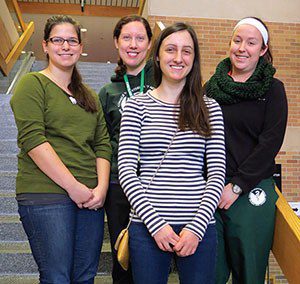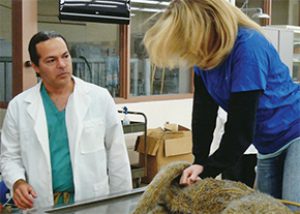The Next Generation in Emergency Veterinary Care

At the Veterinary Medical Center, Drs. Matthew Beal, Ari Jutkowitz, and Amy Koenigshof work closely with students interested in emergency and critical care and offer a number of opportunities for preclinical students to get involved. The SVECCS provides an organized structure for students to get additional hands-on experience in critical care.
SVECCS members participate in ICU shadowing and wet labs, and they have the opportunity to attend the annual International Veterinary Emergency and Critical Care Symposium. Society members also are able to work closely with the emergency clinicians, technicians, and senior students. “ICU shadowing is a unique feature of the club,” says Lindsey McGuire (DVM ’13), 2011 SVECCS vice president. “Students are able to sign up for shifts in the small animal ICU and get some exposure to emergency and critical cases before the clinical phase of our education.”
The life-saving capacity of emergency and critical care medicine is compelling for some students. “I attended a SVECCS lunch session, and saw Dr. Beal deliver a presentation that drove home veterinary medicine’s abilities in emergency and critical care—I was hooked,” says Chelsie Barrett-Narito (DVM ’13), who served as the organization’s president in 2011.
The emergency radiology program is another opportunity for SVECCS members to get hands-on experience in the hospital. Students undergo training with diagnostic imaging and emergency and critical care technicians before participating in the program, which offers paid positions. Participants take emergency radiographs for after-hours patients.

A summer fellowship in emergency and critical care medicine is also available to SVECCS members, says current SVECCS president Kristen Seymour (DVM ’15). She describes it as a position that mimics the responsibilities of a fourth-year student while still in the preclinical stage of her education.
“A lot is expected of you,” she explains. “It’s a sharp learning curve, but we get the full experience.” Fellowship students meet clients and take patient histories, present case information to supervising clinicians, and eventually help develop diagnostic and treatment plans. “At the beginning of the summer I wasn’t able to come up with a list of differential diagnoses,” Seymour says, “but by the end of the summer I could.”
Now starting her third year, Seymour says the preclinical class is learning about diseases that she already has seen firsthand. “I’m much further advanced than I would otherwise have been,” she says. Her experience in emergency radiology and emergency and critical care has left her passionate about this lifesaving specialty.
SVECCS is a stepping stone and entry path to specializing in emergency and critical care medicine. In June, McGuire begins an internship at North Carolina State University's College of Veterinary Medicine. Barrett-Narito begins a one-year internship in June at the VCA Emergency Animal Hospital and Referral Center in San Diego, California. “The hospital is heavy in emergency,” she says, “and I am interested in pursuing a residency in emergency and critical care. Throughout the years, I’ve remained open-minded to different specialties, but I always gravitate back to emergency medicine.”
Posted: June 10, 2013
Contact: Casey Williamson
